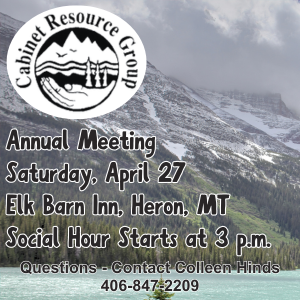Remember When
January 14, 2021
THE MARTIN QUINNS WERE AMONG THE EARLY SETTLERS
Excerpt from Wild Horse Plains Centennial Issue - 1983
One of the more prominent of the early day settlers in the Plains area was Martin Quinn who came to western Montana as a miner but spent the greater part of his adult life as operator of a resort area known, and still operating at the present time, as Quinn’s Hot Springs.
Quinn, a native of Ireland, and his wife of a few years, a native of England, arrived in the area a year after the Northern Pacific Railroad was completed in 1883. They started the community of Pardee (later Iron Mountain) and opened up the Iron Mountain mine which later, but not for Quinn, produced millions of dollars in silver. The mine was located about ten miles east and north of Superior, a community which had already established reputation as the center of a prolific mining area.
There was ore at Iron Mountain but no way to get it to a smelter, and it was while searching for the most accessible route for the ore that Quinn discovered the ever-flowing hot springs which he later developed.
The closest rail line to the mine was at Paradise but there was no way to get the ore there. It wasn’t until 1910 that Northern Pacific constructed the alternative water-level route which passed through the St. Regis cut-off. Quinn found a downhill route from the mine to the river at Cascade rapids and the first ore reached the river by a wagon road he hand-built with the few tools he had on hand. It was taken from there by barge down river to the railroad. Parts of Quinn’s hand-built road remain and can be accessed by a trail that starts at the Cascade Campground on the St. Regis cut-off road.
It was a tedious undertaking and Quinn foresaw a more profitable road to riches through development of the hot springs, so he left the mining to others.
Staking out a homestead Quinn at first hired someone to stay on it until he could close out his mining operations and then moved to the springs where he began a series of developments. The first bath house was a log building with a wooden tub. Later, when lumber became available, Quinn hauled it by barge to the springs and eventually replaced the bath house with a more modern structure. He also built a commodious residence for his family.
The Quinn’s did most of their trading in Plains and used pack trains and boats to get their purchases to the resort. The absence of a road until 1930 didn’t keep people from all parts of the country from coming to take the baths and hunt the abundant Rocky Mountain sheep and deer. They sometimes stayed for months.
At first, access to the springs was made only by foot or by boat, but in 1910 when the Northern Pacific laid their railroad line through the cut-off a new mode of transportation opened up which proved to be a boon to the resort business.
The rail line was across the treacherous Clark Fork River from the resort, but that was quickly surmounted by Quinn. He had a swinging bridge constructed across the river. The work, an engineering feat of the day, was done by Vic Hane who with his wife Laura lived for many years in Plains.
With the bridge in operation Quinn’s business increased. Sojourners arrived by train which stopped at the bridge upon request. Quinn would then take his wheelbarrow across to meet the train and return with the luggage. His guests would get their first thrill of their stay by crossing the river on the swaying bridge.
By this time additions had been made at the resort. The original home had been replaced with a frame structure, the bathhouse had also been replaced and upwards of 50 tents with wood floors had been constructed for use by resort guests. The trains, making trips each way on alternating days, kept bringing new guests and departing with those who had completed their stay.
In 1930 Quinn and the county cooperated in constructing the first road from the resort to the Northrup place at the present junction of the cut-off road and Highway 200. In 1934, two years after Quinn’s death, the road was completed to the ferry site past Quinn’s, and at the same time a road was constructed on the other side of the river from the ferry to St. Regis.
Work on the two sections of road was done by Civilian Conservation Corps workers. One camp was at Quinn’s, one at the ferry site and one seven miles east of St. Regis. At the same time, the CCC’s built a road over Siegel pass connecting with one constructed up the Nine Mile canyon.
For years, the treacherous, sometimes one-lane road and the river current-powered ferry were the only methods of getting from Highway 200 to St. Regis. It wasn’t until about 15 years ago (1968) that a modern highway was built to replace the cow path that cars used on the “shortcut.”
During their life at the resort the Quinn’s were never troubled by Native Americans although occasionally they might break into the storeroom and take a ham. But never, Harwood remembers his grandfather as saying, without leaving enough venison to replace it.








Reader Comments(0)